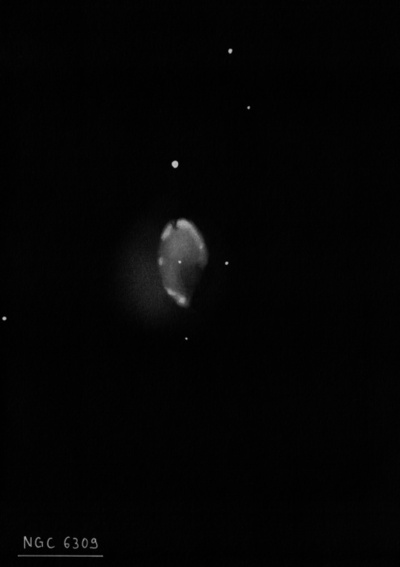Box Nebula
Box Nebula

Wilhelm Tempel discovered NGC 6309 = T I-46 = T V-31 in 1876 using the 11" refractor at the Arcetri Observatory in Florence. He only gave a rough position in his first discovery list I (AN 93, p. 59) but measured an accurate position in 1879 that was published in his fifth list. Edward Pickering found the planetary on 15 Jul 1882 with the 15-inch refractor at Harvard College Observatory using a direct-vision spectroscope and noted "nebula found by Tempel (GC 4851). Tempel's description 'between 2 stars' does not seem applicable." There is only one close star. Herbert Howe described NGC 6309 as a close double nebula, using the 20-inch refractor in Denver. NGC 6309 is the only planetary discovered by Tempel. Both this planetary and NGC 6445 are referred to as the "Box Nebula".
Based on Crossley photographs at Lick, Curtis (1918) reported "at first sight this nebula appears binuclear, but the southern condensation is not stellar. Quite irregular; about 19"x10" in p.a. 163°. The southern condensation is 7.5" from the central star."
300/350mm - 13.1" (7/27/84): moderately bright, small, elongated NNW-SSE. A mag 12 star is at the NNW edge 20" from the center. Appears slightly brighter or a condensation is at the SSE end.
400/500mm - 17.5" (6/30/00): at 280x using a UHC filter, this bright but compact PN was elongated 2:1 in the direction of a 12th magnitude star at the NNW edge, with dimensions of ~25"x12". There is a large, bright lobe or condensation at the north end with a smaller, fainter knot at the SSE end. At moments the lobes appear completely "resolved" with a darker gap in the center. The view at 500x was excellent! The fainter southern lobe appears elongated and slightly offset from the major axis of the PN. The lobes are bisected by a darker lane oriented SW-NE and oblique to the minor axis. The brighter knot at the north end has a mottled appearance and irregular shape.
600/800mm - 24" (8/13/15): this very bright, bipolar, compact planetary was viewed at 375x and 500x. The two lobes are extended at least 3:2 NNW-SSE with an overall size of ~25"x16" and a pear shape. A bright, roundish lobe is on the NNW side and a 12th magnitude star is off this side in the direction of the major axis [22" from center]. The smaller lobe on the SSE end is slightly fainter and separated by a small darker gap near the center. A mag 15 star is just off the west edge [14" from center]. An extremely faint outer shell or extension was just visible bulging out on the east side perhaps 10", creating an asymmetric appearance.
24" (7/16/15): excellent view at 450x unfiltered. The larger and brighter lobe on the north-northwest end appeared roughly circular and slightly brighter along the outer rim. The smaller knot on the south-southeast end is slightly irregular and the nebulosity dims near the center. A mag 12 star is just north of the north-northwest end.
Notes by Steve Gottlieb